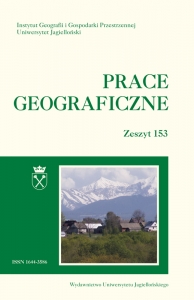Anthropogenic Denudation in Mining Areas on the Example of the Wałbrzych coal mining area (Sudetes, Poland)
Anthropogenic Denudation in Mining Areas on the Example of the Wałbrzych coal mining area (Sudetes, Poland)
Author(s): Jan WójcikSubject(s): Energy and Environmental Studies, Physical Geopgraphy, Recent History (1900 till today), 19th Century
Published by: Wydawnictwo Uniwersytetu Jagiellońskiego
Keywords: Wałbrzych coal mining area; coal mining; anthropogenic forms; anthropogenic denudation; anthropogenic aggradation;
Summary/Abstract: In the 20th century Wałbrzych and its surroundings was the most prominent area of coal mining in the Sudetes. Nevertheless, in 1997 the mines were closed. An intensive anthropogenic geomorphic cycle commenced there in 1865 and lasted for 130 years. The biggest transformations in landforms occurred in two basins: Wałbrzych and Kuźnice, where a complex of anthropogenic forms was created from dumps and settling ponds, as well as subsidence depression. Among the dominant geomorphic processes related to anthropopressure were anthropogenic aggradation and anthropogenic denudation. Those processes resulted in raising and lowering of the land surface. Their intensity was diverse both in time and space. The average pace of anthropogenic aggradation in the years 1865–1996 amounted to 328 mm/year and was higher in the years 1945–1996 (439 mm/year) than during the period from 1865 to 1944 (255 mm/year). In both basins: Wałbrzych and Kuźnice, there was an increase in the intensity of this process in the years 1945–1996 when compared to the period of 1865–1944. The pace of anthropogenic denudation in the Wałbrzych coal mining area was considerably lower than the intensity of anthropogenic aggradation. During the research period, the land surface lowered, on average, by 66 mm/year, whereas the pace of the process decreased from 75 mm/year in the years 1865–1944 to 57 mm/year in the period 1945–1996. A considerably higher intensity of anthropogenic denudation was noted the Wałbrzych Basin (96 mm/year) than in the Kuźnice Basin (36 mm/year). It was determined that the anthropogenic denudation balance in the in the Wałbrzych coal mining area in the years 1865–1996 was positive (+262 mm/year). When comparing the scale of anthropogenic aggradation and denudation in several coal mining areas (Wałbrzych, Upper Silesia, Ostrava-Karvina and Ruhr), it needs to be emphasized that in the research area the intensity of those processes in the period 1865–1996 was similar and, at times, higher than in the other areas, which results from the preference of cumulating of gangue on spoil tips as the cheapest way of its disposal, as well as from the dominance of caving coal extraction.
Journal: Prace Geograficzne
- Issue Year: 2018
- Issue No: 153
- Page Range: 105-131
- Page Count: 27
- Language: English

